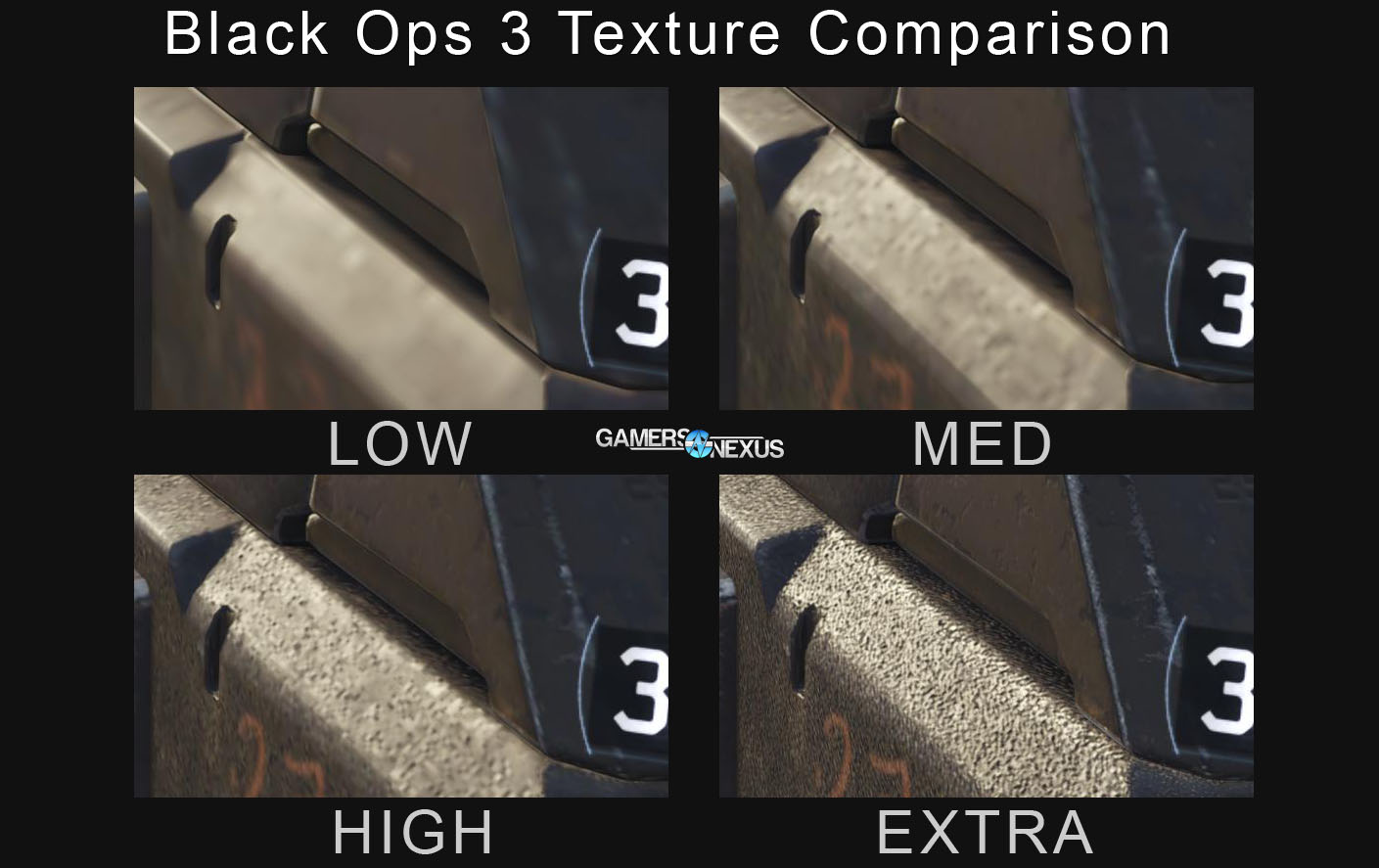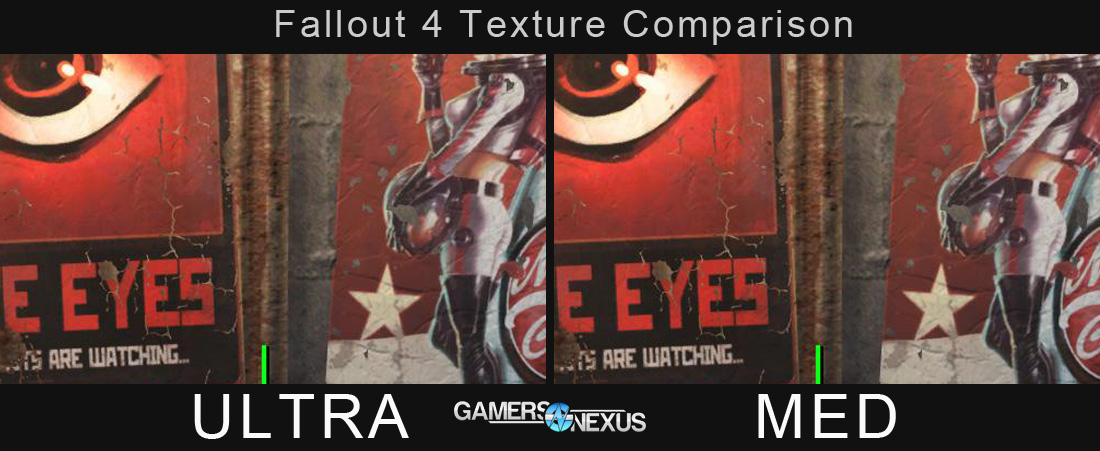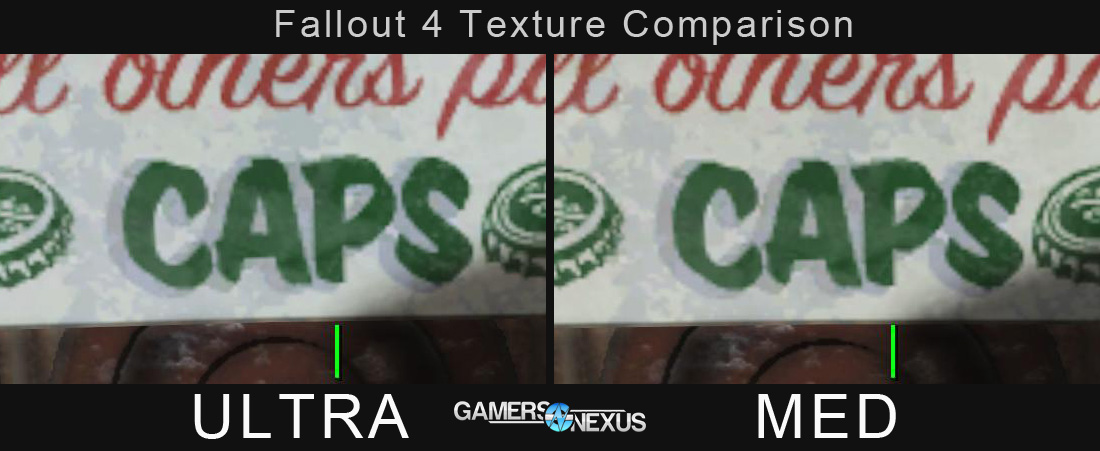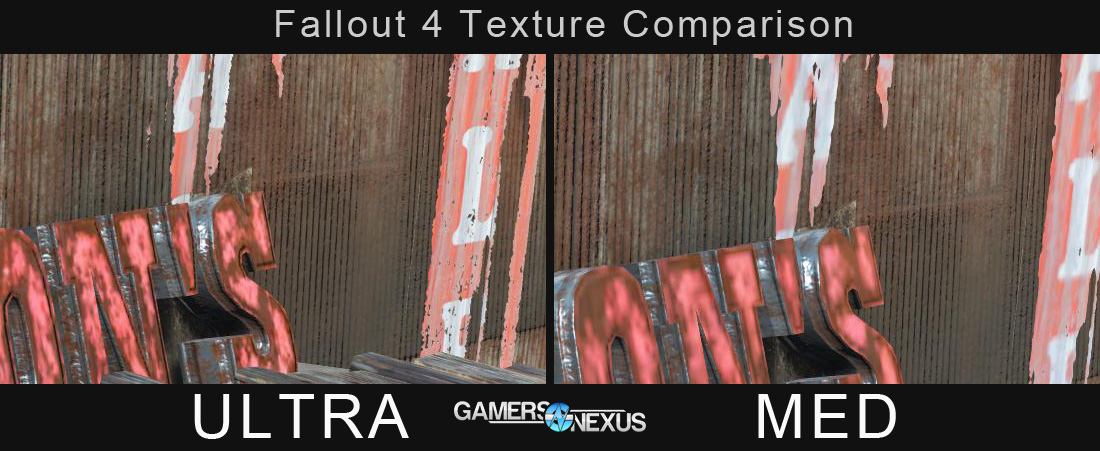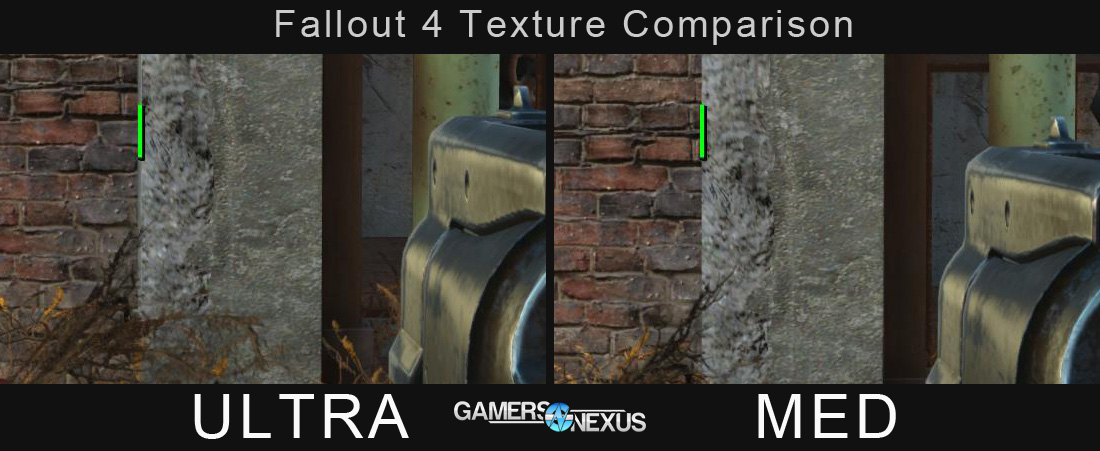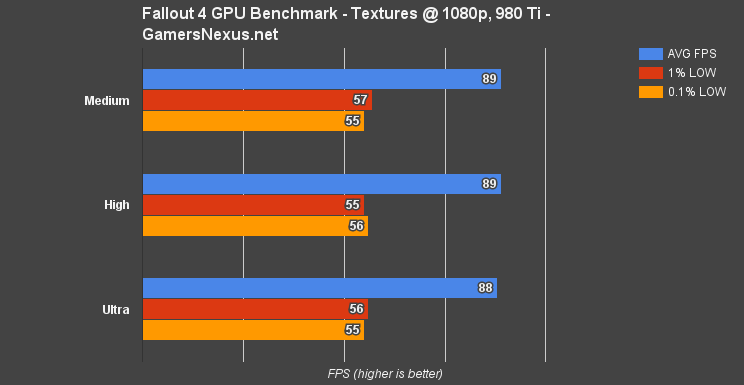In suit of our Fallout 4 GPU benchmark and the follow-up Volumetric Lighting Benchmark, we're now looking toward Bethesda's odd texture quality presentation. Fallout 4 includes with it a Texture Quality option, which should dictate the resolution of textures as applied to game elements. The setting scales from medium to ultra, with one step (“high”) in between. Usually – especially in Black Ops III, as we found – texture resolution can have profound impact on performance and VRAM consumption, leading us to run some texture tests in Fallout.
Here's an example of what we're used to when it comes to texture quality comparisons:
Example of Texture Quality Scaling from Black Ops III
And here's what we get in Fallout 4:
Fallout 4 Texture Quality Comparison
Above: We found Waldo!
Effectively no difference. The only texture set for which there is a visible difference is the one with the trash can (and fallen sign), wherein the dilapidated signage exhibits lower resolution rust texturing and less sharp lettering on the nearby tapestry. The rest are effectively identical in visual output.
Test Methodology
We tested using our 2015 multi-GPU test bench, detailed in the table below. Our thanks to supporting hardware vendors for supplying some of the test components.
NVidia's latest 358.91 Fallout 4 drivers were used for testing, including the Fallout 4 optimizations. The latest AMD Catalyst drivers (15.11 beta) were used for testing. Game settings were configured to "Ultra" with “ultra” overrides where not selected, "Medium," and “Low” presets at 1080p, 1440p, and 4K resolutions. Once we determined which settings provided a reasonable level of load for appropriate video cards, we forged forward testing those configurations on our suite of GPUs.
Each scenario was tested for 30 seconds identically, then repeated three times for parity. We tested in Diamond City, the first major township the player reaches. We found parts of Diamond City to produce highly intensive load, with a performance gap as wide as nearly 60% in some instances. This makes Diamond City a poorly optimized region of the game that represents a mixed load scenario; our test run begins with the camera pointed toward a heavily occupied region of the city, then moves around a much less intensive corridor. The result is a mixed GPU load that is 100% reproduceable and representative of real-world play experiences.
Our above video shows the course we used. This was chosen for its reproducibility and reliability during test. Benchmarks which do not precisely emulate our course taken will vary in results, depending on what area of the game they were executed.
| GN Test Bench 2015 | Name | Courtesy Of | Cost |
| Video Card | This is what we're testing! | - | - |
| CPU | Intel i7-5930K CPU | iBUYPOWER | $580 |
| Memory | Kingston 16GB DDR4 Predator | Kingston Tech. | $245 |
| Motherboard | EVGA X99 Classified | GamersNexus | $365 |
| Power Supply | NZXT 1200W HALE90 V2 | NZXT | $300 |
| SSD | HyperX Savage SSD | Kingston Tech. | $130 |
| Case | Top Deck Tech Station | GamersNexus | $250 |
| CPU Cooler | NZXT Kraken X41 CLC | NZXT | $110 |
Average FPS, 1% low, and 0.1% low times are measured. We do not measure maximum or minimum FPS results as we consider these numbers to be pure outliers. Instead, we take an average of the lowest 1% of results (1% low) to show real-world, noticeable dips; we then take an average of the lowest 0.1% of results for severe spikes.
We used similar texture comparison methodology to our GTA V & Witcher 3 texture comparison articles. The Titan X was put to use for benchmarking.
For purposes of this graphics comparison, we took easily replicable steps on each texture resolution setting to ensure accuracy of results. All graphics settings were configured to their maximum value on the “graphics” tab, with the exception of anti-aliasing (FXAA). Screen resolution was set to 4K for the screenshots, but benchmarks were taken at 1080p and 4K (only reporting on 1080).
We traveled to preselected locations. Once there, we stood on designated “landmarks” and took the screenshots.
We face two issues with presentation of screenshots as data: They're massive, consuming large amounts of server bandwidth and greatly hindering page load time, and they're comparative, so we've got to find a way to show multiple shots at once. In order to mitigate the impact of each issue, we used a selection marquee of 546x330, selected a detailed portion of the 4K image, and then pasted it into the documents shown below. There is no scaling involved in this process.
Because file sizes were still an issue, we then scaled the finalized document into an 1100-width image, embedded in this article.
1080p Texture Quality FPS Impact on 980 Ti
The performance delta measures-in at less than 1FPS on average:
Confused at Bethesda's Purpose
I'm not sure I understand why texture quality is present as an option. We were able to pinpoint a few rare instances where the textures actually changed between Medium and Ultra, the two opposing points on the settings scale. When it requires work to find the change, and when the FPS delta is as insignificant as it is, it's tough to say what the setting really is doing for anyone. The signs look the same, the armor looks the same, the character clothing looks the same, the ground looks the same, the walls look the same. It's that one fallen sign and the “tapestry” (for lack of a better name) where we see the difference, along with a few similar objects throughout the entire game.
If you're trying to get a few FPS out of a setting, this isn't the place to go. We'd recommend tweaking volumetric lighting and shadow distance first, where we saw gains in the respective ~12% and ~16% ranges.
That said, bottlenecking on VRAM could be a problem for users with older 1GB cards and maybe on 2GB cards. If encountering VRAM bottlenecks, dumping textures to “high” will resolve some of this.
- Steve “Lelldorianx” Burke.
